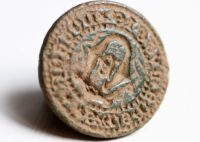 Seal stamps from the 1300s are rare finds, and ones that belonged to women are as rare as it gets. Finding the seal of a 14th century woman who actually appears by name in historical sources is practically unprecedented. Lasse Rahbek Ottesen, a truly committed amateur archaeologist, has done just that, discovering the bronze seal of Elisabeth Buggesdatter at Hodde in western Jutland.
Seal stamps from the 1300s are rare finds, and ones that belonged to women are as rare as it gets. Finding the seal of a 14th century woman who actually appears by name in historical sources is practically unprecedented. Lasse Rahbek Ottesen, a truly committed amateur archaeologist, has done just that, discovering the bronze seal of Elisabeth Buggesdatter at Hodde in western Jutland.
Elisabeth Buggesdatter was the daughter of Niels Bugge, one of the richest men in Jutland. He was on the council of King Valdemar IV Atterdag and fought with the ambitious monarch against the Margraviate of Brandenburg and the Duchy of Mecklenburg in 1349, but he turned on the king when Valdemar sought to wrest control of Jutland from the nobles. Niels Bugge was one of the leaders of a rebellion against Valdemar in the early 1350s. The rebellion ended with a treaty in 1353, but tensions flared repeatedly over the decade. Bugge was one of three members of Jutland’s ruling nobility who met with Vademar the Christmas of 1358 to discuss detente. The discussions failed and all three men were assassinated on their way home.
One of his most important holdings, the estate of Hald near Viborg, he acquired through his second wife Ingeborg Pedersdatter. Their daughter Elizabeth was born around 1346. After her father’s murder, Elisabeth inherited Hald. She married Gotskalk Skarpenberg, member of a German noble family that had immigrated to Denmark in the 13th century, and established herself as a prominent figure in Danish society. She spoke at the tinge, the legislative and judicial assemblies of medieval Denmark, and is noted in the historical record as a wealthy property owner. She sold the family estate of Hald to Queen Margrete (possibly under less than entirely voluntary conditions) but her will attests that she was still a rich woman when she died around 1402.
Her political prominence, extensive property holdings and wealth would have made a personal seal stamp a necessity for Elizabeth to see to her business. Seals were impressed into wax and the stamped wax affixed to legal documents, property deeds, declarations, anything that needed the official imprimatur of relevant parties. The stamp was like a signature on steroids. If it was lost or stolen, someone of nefarious intent could sign documents under that person’s name, a medieval version of identity theft. When someone died, their seal was usually destroyed to prevent shenanigans. That’s why few of them have survived.
Ottesen had to work hard to find this one. He wasn’t just scanning a field with a metal detector, although he has done that too. He researched the hell out of it, using aerial photography, topographical analysis, studying place names and the historical record. Then he deployed the ol’ shoe leather technique, systematically walking a snowy field in the morning sun looking for glass, flint or anything else of archaeological significance. He found the stamp on the ground, took a picture of it and sent it to the local museum.
That was four years ago. The seal has since been studied by experts at the National Museum and now we know who wielded it in life.
That the seal belonged to a woman was confirmed after examination by the National Museum, which found the inscription ‘Elsebe Buggis Dotter’, meaning Elisabeth Buggesdatter, on the stamp.
“It is outstanding to be able to connect this very personal object to a person we know from historical sources,” National Museum curator Marie Laursen said.
“That the owner was a woman who was among the leading figures in society in the 14th century makes this discovery even more spectacular,” she added.
I wonder if there are any surviving documents on which this seal was used.
While on the line of wondering, just why was Ottesen researching this particular field?
I can’t figure out the design in the center of the seal. The only thing that I can come up with is a weaving shuttle which would be appropriate for a woman.
It looks like a whale to me.
“Elsebe Buggis Dotter’, meaning Elisabeth Buggesdatter“? Well, really now, doesn’t it mean, “Elizabeth, Bugge’s daughter”???
The word “Bugge”, the family name, means “badger” in old Danish. So it´s most likely a badger.
Don’t know for sure, but according to http://www.geni.com, Elizabeth Buggesdatter is my 17th Great Grandmother.
Don’t know for sure, but according Elizabeth Buggesdatter is said to be my 17th Great Grandmother.